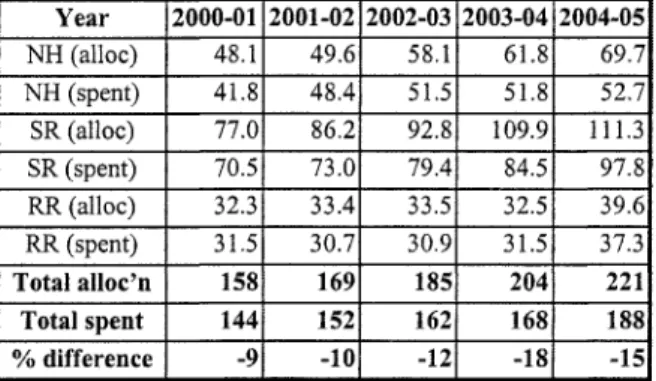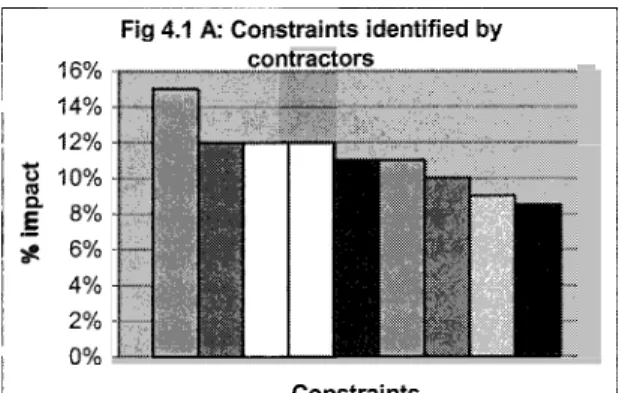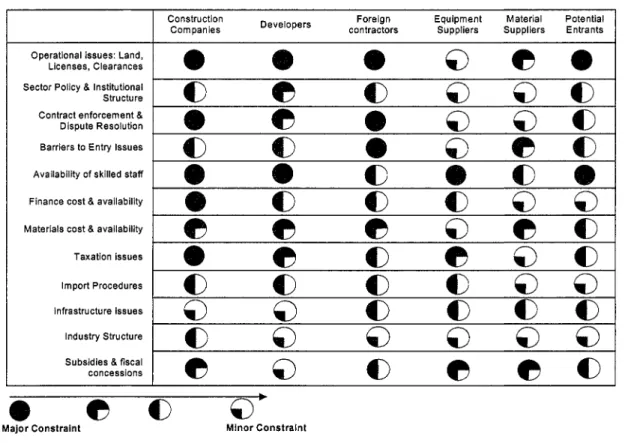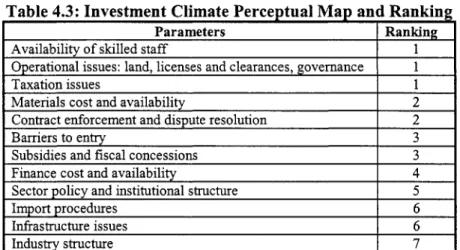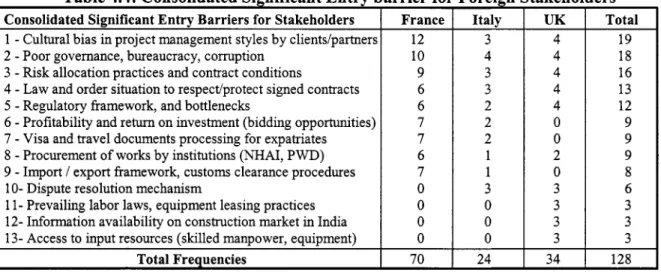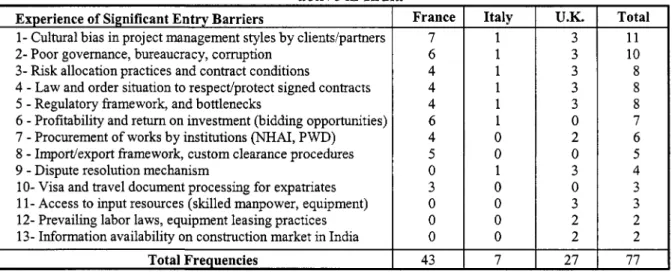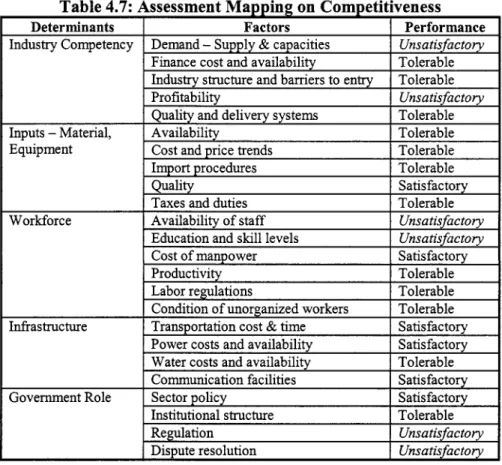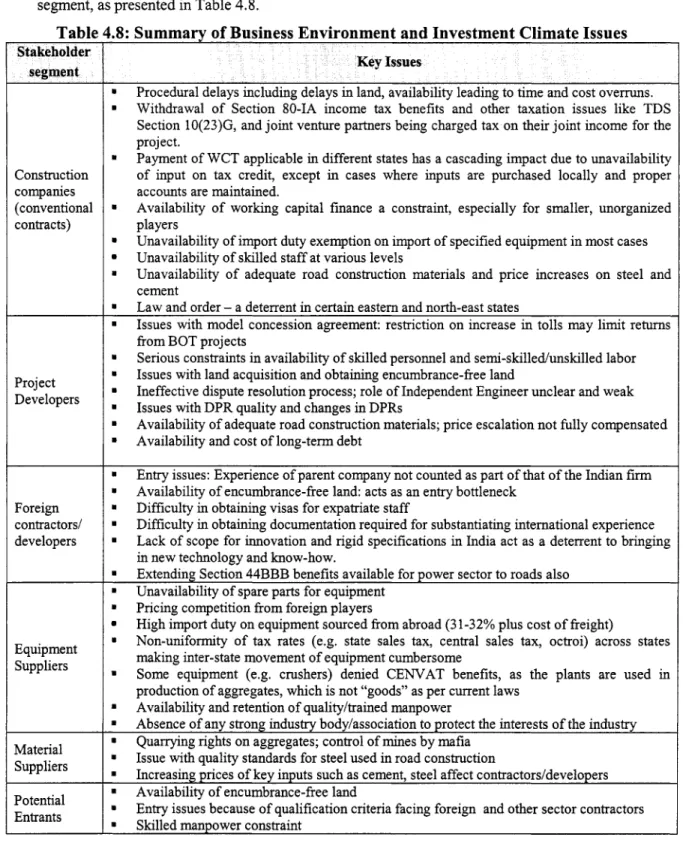November 2008
Document of the World Bank
Report No. 46326-IN India Indian Road Construction Industry
Report No. 46326-IN
India
Indian Road Construction Industry
Capacity Issues, Constraints & Recommendations
South Asia Region
India Country Management Unit Sustainable Development Department Transport Unit
Public Disclosure AuthorizedPublic Disclosure AuthorizedPublic Disclosure AuthorizedPublic Disclosure Authorized
Acknowledgements
The task team would like to acknowledge the timely support, help and advice it received from Messrs. Guang Chen and Michel Audige, previous and present Sector Managers respectively - Transport, South Asia Region. Valuable and expert inputs have been provided by Messrs D P Gupta, Peter Copplestone, Hugues Castaing, Harish Chawla, Sujit Das and Jean-Noel Guillosou in preparing this report as members o f the extended task team. Messrs N S Srinivas and Rajesh B S Dongol provided excellent administrative, editorial and logistic support during the preparation and finalization o f this report.
Data collection, interviews and much o f the analyses and recommendation flow from work done by the two consultant firms Consulting Engineering Services (India) Pvt. Ltd. and ICRA Management Consulting Services Ltd.
Quality and peer reviews were done both at the concept stage and final report stage by Messrs Ani1 Bhandari, John Scales, Simon Thomas, h e r Durrani, Mohan Nagarajan and Cesar Queiroz. The team has also shared the draft report with the procurement hub, finance & private sector development unit and the IFC within the Bank. During periodic internal progress reviews, key inputs were provided by Messrs Alok Bansal, Krishnan Srinivasan, Ashok Kumar, Debabrata Chakrabarty and George Tharakan. The task team also wishes to acknowledge the authors o f the various Bank reports which have been referred to in the study. The task team also wishes to extend its appreciation to Mr Graham Smith for the final technical editing o f the report.
The work done by the consultants and the study recommendations were shared with key stakeholders from the government and the private sectors during a workshop held on June 13, 2007. Comments and views expressed by the industry and all government agencies during the data collection and interview phase i s gratefully acknowledged by the team. After internal reviews within the Bank the modified report was shared with the Government o f India (Department o f Economic Affairs) in November 2007 for comments. On receiving the Government’s response and its valuable observations in September 2008, the report i s now finalized.
i
Exchange Rate
Indian Rupees (INR): Rs. 45 = US$ 1 .OO
BOT BRO CAGR CCF CDC CIDC C I I D B M O CFI DFO D P DPR DRB ESOP FDI FICCI FIDIC GO1 GPS GSHP HR IRC IT Jv
LTPBC LA M C A M H A MoEF MoSRTH NABARD N A C NH NHAI NHDP NSE PAP PMGSY PPP PWD R&D R&R RR SH SME SOE SPV VAT VE WCT
List of Acronyms Build, Operate and Transfer Border Roads Organization Compound Annual Rate o f Growth C h e f Conservator o f Forests Consultancy Development Council
Construction Industry Development Council Confederation of Indian Industries
Construction Federation o f India Design, Build, Maintain and Operate District Forest Officer
Displaced person Detailed Project Report Dispute Resolution Board Employee Stock Option Plan Foreign Direct Investment
Federation of Indian Chambers of Commerce and Industry International Federation o f Consulting Engineers
Government o f India
Global Positioning Satellite/System Gujarat State Highways Project Human Resources
Indian Road Congress Information Technology Joint Venture
Long-term Performance-based Contract Land Acquisition
Model Concession Agreement Malaysian Highway Authority Ministry o f Environment and Forestry
Ministry of Shipping, Road Transport and Highways National Bank o f Agriculture and Rural Development National Academy o f Construction
National Highways
National Highways Authority o f India National Highways Development Project North-South Expressway
Proj ect-affected person
Pradhan Mantri Gram Sadak Yojana (Prime Minister’s Rural Roads Program) Public Private Partnership
Public Works Department Research and Development Resettlement & Rehabilitation Rural Roads
State Highways
Small and medium enterprises State-owned enterprise Special Purpose Vehicle Value Added Tax Value Engineering Works Contract Tax
11
Acknowledgements ... i
L E X E C U T I V E SUMMARY ... 1
A BACKGRO~D ... 1
B INDUSTRY STRUCTURE AND PROFITABILITY ... 2
C . KEY CONSTRAINTS FACED BY THE ROAD CONSTRUCTION INDUSTRY ... 3
C.I Constraints in Investment Climate C.II Supply-side Constraints ... D . KEY RECOMMENDATIONS AND SU D . I ... 5
D.II Medium-Term Actions (2 - 5 years) ... 8
D.III Long-Term Actions (5 - I O years) ... 9
E . SUGGEST10N FOR TAKING FORWARD THE REC~MMENDAT~~NS OF THIS STUDY ... 9
F . POSSIBLE AREAS FOR WORLD BANK’S FUTURE ASSISTANCE ... 9
2 . INTRODUCTION ... 10
2.1 CONTEXT ... 10
2.2 MACRO ECONOMIC PERSPECTIVE ... 10
2.3 DEMAND FOR ROADS IS OUTSTRIPPING THE SUPPLY ... 11
2.4 GOVERNMENT’S INITIATIVES AND ROADS DEVELOPMENT PROGRAM ... 11
2.5 THE CURRENT INDUSTRY FRAMEWORK AND CHALLENGES AHEAD ... 12
2.6 DRIVER AND OBJECTIVES OF THE STUDY ... 13
2.7 STUDY METHODOLOGY ... 14
3 . PAST PERFORMANCE OF ROAD CONSTRUCTION INDUSTRY ... 16
3.1 CONTEXT ... ... 16
3.2 ANALYSIS OF THE PAST DEMAND ... 16
3.2. I Comparison of budget allocations and actual expenditure in the past 16 3.3 INDUSTRY’S RESPONSE TO MEET THE PAST DEMAND ... 16
3.3.2 Utilization of input resources by the industry ... 17
3.3.3 Contract Size and Framework 3.3.4 Time and Cost Overruns ... 3.3.5 Participation of Foreign Contractors in the Pas 3.3.6 Migration of Contractorsfrom Other Sectors to ast ... 20
20 4 . KEY ISSUES FOR THE ROAD CONSTRUCTION INDUSTRY ... 23
4.1 CONTEXT ... 23
4.2 KEY ISSUES IDENTIFIED THROUGH THE PRIMARY SURVEYS ... 23
4.2. I Issues identified on input resources and operational aspects 23 4.2.2 Issues Identified on Business Environment ... 24
... 25
4.2.4 Experience of some Asian Contractors in India ... 27
4.2.5. Entry Barriers Experienced and Perceived by F o r e i p Construction Firms 28 4.3 CRITICAL ISSUES PERTAINING TO CAPACITY OF THE ROAD CONSTRUCTION INDUSTRY ... 28
4.4 BUSINESS ENVIRONMENT AND INVESTMENT CLIMATE ISSUES ... 28
4.4. I Pre-construction and Implementation Issues 28
Immediate and Short-term Actions (0 to 2 years): ...
3.3. I Industry Output / Turnover .. I 7
3.3.7 Facilitation by Government to Strengthen the Road Construction Industry
4.2.3 Perceptions of Foreign Contractors, Consultants and Equipment Manufacturers
4.4.1.1 Pre-construction Activities 29
4.4.1.2 Land Acquisition and Relocation o f Displaced Persons ... 29
4.4.1.3 Utility Relocation ... 31
4.4.1.4 Tree Cutting 4.4.2 Construction an 4.4.2.1 Contract Enforcement and Decision Making ... 34
4.4.2.3 Claims and Disputes ... 34
4.4.3 35 4.4.3.1 Institutional Structure and Regulation ... 36
4.4.3.2 Cost of Funds ... 31
4.4.3.3 Tax Structure, Incentives an ies ... 31
4.4.3.4 Entry barriers to road sector ... 38
4.4.3.5 AdministrativeRrocedural Issues - Licensing, Clearances, Governance, Law and Order 39 4.4.3.6 Profitability and Returns ... 39
4.4.4 Summary of Business Environment &Investment Climate Issues ... 40
4.5 SUPPLY CONSTRAINTS FACED BY THE INDUSTRY ... 41
4.5.1 Lack of Contractors - in Numbers and Capacity ... 41
4.5.2 Constraints Directly Related to Road Contracting Industry 4.5.3 Consultant Issues: Surveying, Investigation and Design Issues ... 42
4.5.3.1 Quality of Survey Reports and Lack o f Modem Surveying Techniques 4.5.3.4 Unrealistically Low Consultant Fees ... 43
4.5.3.5 Lack o f Thrust on Quality Control and Optimization o f Costs 4.5.3.6 Accountability of the Consulting Industry ... ... 44
4.5.4 Human Resources and Skills Development Issues ... 44
5 . ASSESSMENT OF DEMAND OVER THE MEDIUM TERM ... 46
5.1 CONTEXT ... 46
5.2 PROJECTION OF FUTURE DEMAND ... 46
5.2.1 The three scenarios ... 46
5.2.2 Items covered in Demand Projections 5.2.4 Projection on Number of Contra 5.2.5 Projection on Human Resources equirements ... 49
49 5.2.7 Projection on Critical Construction Materials ... 50
5.3 GAP ANALYSIS ... 50
5.3.1 Number of Contracts vs . Contractors ... 50
5.3.2 Human Resources . 51 5.3.3 Key Construction Equipment ... 52
5.3.4 Key Construction Materials 52 6 . EXPERIENCE ON EVOLUTION OF THE INDUSTRY ... 54
6.1 CONTEXT ... 54
6.2 SELECTION OF COUNTRIES ... 54
6.3 CHINA CASE STUDY ... 54
6.3. I History of Highway Development ... . 54
6.3.2 How Was It Achieved? ... 55 4.4.2.2 Contract Management by Contractors and Su
Investment Climate Issues Affecting Competitiveness o f the Industry ...
5.2.3 Projection of Expenditure ...
5.2.6 Projection on Key Construction Equipment
iv
6.3.2.1 Building Management Capacity ... 55
6.3.2.2 Industry Structure ... ... 6.3.2.3 Building Manpower Capacity ... ... 6.3.2.4 Building Equipment Capacity ... 56
6.3.2.5 Materials Capacity 56 6.3.2.6 Regulations and Associations ... 57
6.3.2.7 Funding Restructuring ... 6.4 MALAYSIA CASE STUDY ... 57
6.4.IHistory ofHighway Development ... 57
6.4.2 How was it achieved 6.4.2.1 Building Manage 6.4.2.2 Industry Structure 6.4.2.3 Building Manpow ... 59
6.4.2.4 Building Equipment Capacity ... 6.4.2.6 Regulations and Associations ... 59
6.4.2.7 Funding Restructuring ... ... ... 59
6.5 LESSONS LEARNT (FROM CHINA & ... 59
6.6 CASE STUDY ON FRANCE ... 60
6.6.1 Key Issues of the French Road Construction Industry in the Last Decade 61 6.6.2 Government Policies Implemented to Improve the Construction Sector Capacity ... 61
6.6.3 Internal actions taken by the French road construction industry to improve its capacity 6.6.4. Key issues and strategy of the Road Construction Industry in the past and near future ... 6.7 CASE STUDY ON GUJARAT - GUJARAT STATE HIGHWAYS PROJECT ... 63
7.2 KEY AREAS OF RECOMMENDATIONS AND SUGGESTED ACTIONS ... 65
7.2. I Speeding up Contract Execution through Improved Qualiv at Entry ... ... 65
7.2.1.1 Timely Completion o f Pre-Construction Activities ... 65
7.2.1.2 Strengthening the Investment Planning and Programming Functions o f the Road Agencies ... 66
7.2.1.3 Structuring Contractor and Consultant Arrangements Differently ... 66
7.2.2 Increasing the Number of Contractors and Consultants Working in India's Road Sector ... 67
7.2.2.1 Making Procurement and Selection Process for Contractors and Consultants more Transparent 68 7.2.2.2 Easing Barriers For New and Foreign Firms to Enter the Road Construction Sector ... 69
7.2.2.5 AdministrativeProcedural Issues - Licenses, Clearances, Tax Administration and Customs ... 70
... 71
... 6.4.2.5-Materials Capacity 7. SUGGESTED ACTIONS & RECOMMENDATIONS ... 65
7.2.2.6 Institutional Structure and Regulation 7.2.2.7 Timely Completion of Contracts. ... 7.2.3 Improving the A 7.2.3.1 Human Resources 7.2.3.2 Equipment ... 7.2.3.3 Material Resources ... ... 7.2.4 Marketing Indian Road Sector a 7.3 EXPECTED OUTCOMES ... 74
7.4 CONCLUDING REMARKS ... 75
...
ience Sharing within
V
Annexes
ANNEX I SUMMARY OF THE STUDY ON THE OPERATION OF DISPUTE RESOLUTION MECHANISM IN
CIVIL WORKS IN INDIA ... 1
ANNEX I1 BUILDING THE CAPACITY OF THE INDIAN ROAD CONSTRUCTION INDUSTRY ... 3
ANNEX I11 CAPACITY ENHANCEMENT OF HUMAN RESOURCES IN THE ROAD SECTOR ... 30
ANNEX I V RESEARCH. DEVELOPMENT AND TECHNOLOGY INITIATIVES IN THE ROAD SECTOR ... 42
ANNEX v OTHER THRUST AREAS FOR R&D AND TECHNOLOGY IN THE ROAD SECTOR ... 49
ANNEX V I THE VALUE ENGINEERING PROCESS ... 51
ANNEX VI1 CASE STUDY: ROAD AGENCY PRIVATIZATION . ACTUAL EXPERIENCE ... 55
vi
1. Executive Summary A Background
1. Over the last few years, the Indian economy has been in a phase o f unparalleled growth o f about 8- 10% per year, malung it one o f the fastest growing economies in the world. Sustaining this rate o f growth will need huge investments in physical infrastructure such as roads ($75-90 billion according to various reports), water, power and urban sectors. Preliminary estimates suggest that investment in infrastructure would need to increase from the current 4.6% o f GDP to about 8% during the 11“ Plan.
2. An efficient transportation system i s critical for sustaining economic growth and the burgeoning demand for passenger and freight movement. Recognizing this, the Government o f India (GOI) and several state governments have launched initiatives during the past decade to modernize and improve the transport infrastructure. Starting with the 9* Five Year Plan (1 997-2002), road sector expenditures have gone up from 3% o f the total Plan expenditure to almost 12% today. These expenditures were primarily for national highway and rural road development programs. In addition, GOI, some state governments and industry associations have taken initiatives such as encouraging private sector participation in highway financing, allowing wholly-owned foreign direct investment in the sector, establishing training centers for construction workers, and devising a gradingrating system for construction firms to foster the growth and efficiency o f the road construction industry.
3. In India as elsewhere, the main element o f road investment is civil works - typically 95% o f the road sector budget. The success o f road sector investments therefore depends on the capacity and capability o f the Indian road construction industry. However, even as the magnitude o f works has gone up significantly in the last decade, the industry has not kept pace with this growth, as evidenced by the under-utilization o f funds allocated to road projects’ and perennial time and cost overruns on national and state highway projects2. The industry i s not yet geared up to meet the potential expanded volume o f work on future road infrastructure projects. Furthermore, it faces evolving demands in the form o f bigger projects involving more demanding technology and complex design, and requiring more sophisticated execution capabilities. At the same time, as it competes for skilled manpower with other booming sectors, the road industry faces increasing turnover o f its experienced staff, dwindling appeal to fresh talent, and several other constraints in investment climate that inhibit i t s operations and attractiveness to firms, both domestic and foreign. These issues pose major risks to the planned rapid catch-up on road sector investments - risks that need to be addressed if the Government’s
development objectives are to be met.
4. This study stems partly from GOI’s concern regarding the capacity o f the road construction industry to deliver, and partly from the Bank’s growing need to understand the impact o f the expanded road investments on the industry’s capacity in South Asia. The study attempts to outline the entire gamut o f problems and capacity constraints faced by India’s construction industry. It builds on previous studies3, reports and industry-wide stakeholder surveys and workshops. I t recommends key actions to the central and state governments and the industry for enhancing its capacity and efficiency.
’ Analysis o f project allocation and expenditure data for the past five years on all categories of roads in India consistently shows that actual expenditures fell short o f budget allocations by 15-20%.
Analysis of data on completed and on-going national and state highway projects shows that ninety percent o f all contracts had a time overrun o f more than 25%; fifty-four percent had a cost-overrun o f more than 25%.
“Road Construction Industry Study (1999)”, “Design and Construction Review Study (draft stage)”, “Study on Improving Dispute Resolution Systems in Works Contracts (draft stage)”,and “Study on Delays due to Pre-Construction Activities in National Highway Projects (Bank’s internal study)”,.
1
B Industry Structure and Profitability
5. The Indian road construction industry is highly unorganized and fragmented. Only about 0.4% o f the 250,000 contractors in India can be classed as medium to large firms (based on the number o f people employed per firm). Many o f the medium and large construction firms are still family owned and lack professional management and work culture. While small and medium contractors have mushroomed in the recent past, large contractors have not grown at the same rate either in size (turnover) or number. Consequently, on the medium to large-sized national and state highway projects there are few contractors to choose fi-om; only about 45-50 Indian contractors and about 10-12 foreign contractors. Often these contractors form joint ventures or consortia among themselves to qualify for most o f these contracts in the country. Subsequently, these contractors suffer from insufficient capacity; the result i s time and cost overruns, related disputes and lower quality. As such, there i s a critical need for reversing the slow growth o f the large contractors and for enhancing the capacity o f all sizes o f contracting and consulting firms.
6. Contractors in road construction make much smaller profits (average typical margins o f 6-10%) than those engaged in construction in real estate (about 20-25%), hydropower and industrial sectors (about 15%). These thin margins are mainly due to the delays in overall project implementation, investment climate bottlenecks and unhealthy competition. Players from other sectors find the road construction sector relatively unattractive due to its lower profit margins, management by predominantly weak public administrations, frequent contractual disputes, challenging project logstics and contract management arrangements. Consequently, whereas the industry should be gearing up to attract players from other sectors to meet the demand, in reality the reverse i s happening: existing road firms are expanding their business interests into other, more lucrative sectors. Moreover, an increasing trend in the industry is for contractors to move up the value chain from traditional construction contracts to build-operate-transfer (BOT) type projects, to minimize their risks. This i s creating a vacuum o f good specialist contractors who can support the bigger players in the industry.
7. It i s heartening to note that, in an effort to meet the surge in demand, deployment o f human resources and equipment has increased substantially, but a shortfall still manifests itself in various forms in road contracts and their procurement. Moreover, the frequent substitution of staff on site (by both contractors and consultants) after contract award points to a shortage o f skilled and semi-skilled manpower, that needs to be addressed.
8. Despite the growing demand, participation o f foreign contractors in India has been steadily declining from 2003-04, possibly due to decline in their annual average turnover from Indian business. About a dozen foreign contractors are operating in India today, but many o f them are not bidding on new contracts. Foreign contractors often face difficulties with taxation and audit procedures, in interacting with sub-contractors and suppliers, and in adjusting to the local work culture. This is a disturbing trend that again highlights an unattractive business environment. On the other hand, the performance o f foreign contractors has also not been up to the mark, raising questions about the value they add.
9. Symptoms o f capacity constraints in both quantity and quality are also evident from the fact that Indian equity research and rating agencies report unexecuted order books o f 5-10 times the annual revenues for some o f the leading construction companies in India to attract potential investors in the company stocks. However, this could mean that, on average, most o f the construction firms would take anywhere between five to ten years to complete their works, which highlights a severe lack o f capacity in the road construction sector. Time and cost overruns much above the original estimates also point to capacity constraints and poor use o f the existing capacity to deliver works on time.
2
C.
10.
11.
12.
c.1 13.
14.
15.
Key Constraints Faced by the Road Construction Industry
From data collected through interviews with both domestic and international contractors, the following have been identified as key constraints:
Investment Climate constraints including operational issues, pre-construction activities, contract management and dispute resolution, institutional structure o f road agencies and other entry barriers; and
Supply side constraints including qualified human resources, key construction equipment and materials
0
Foreign contractors also perceive cultural insensitivity to timeliness, quality and cost, lack o f innovative approaches and laxity in contract enforcement as major constraints.
Road agencies cited as key issues the formation o f so-called paper joint ventures to pre-qualify for contracts, poor quality o f surveys and designs, frequent substitution o f key personnel on site, and poor resource planning by contractors.
Constraints in Investment Climate
Investment climate parameters such as availability o f skilled staff, operational issues (land, licenses and clearances, governance) and taxation were perceived as the prime constraints, followed by material costs, contract enforcement and dispute resolution, barriers to entry, and subsidies and fiscal concessions. Foreign contractors who were surveyed cited as the most critical issues cultural bias in project management style, poor governance, bureaucracy and corruption, risk allocation practices and contract conditions, visa and travel document processing for expatriates, and lack o f information on the road construction industry. Besides these, foreign contractors also perceived some intangible constraints, such as preference given to domestic contractors during the bidding process.
Delays in pre-construction activities are a recurring problem across all road construction contracts.
On average for national highway projects it takes 50% more time than scheduled to hand over encumbrance-free land to the contractors. Often, encumbrances such as the extent o f land acquisition, utilities to be shifted and trees to be removed are not clearly identified and dealt with in a timely manner. These activities are also hampered by cumbersome procedures for obtaining the necessary clearances, unclear laws and regulations and a lack o f coordination between the various government departments and levels. There i s a distinct lack o f a ‘spirit o f partnership’ between the contractor and the employer. This i s critical to effective project execution, as evidenced in other countries. The result i s time and cost overruns and related disputes that invariably end up in litigation.
Although based on the FDIC4 framework, the present form o f contract i s inadequate and often contains unclear clauses that are open to interpretation, which subsequently lead to disputes andor rent-seelung behavior. For instance, the role o f the Independent Engineer i s not clear, weak and often circumvented by the employer, violating the conditions o f contract. Most o f the employer’s staff and domestic supervision consultants have little experience in FDIC conditions o f contract. For instance, there i s a general lack o f awareness that encashment o f a bank guarantee can be invoked only upon default in the contractor’s obligations. Further, the weak accountability framework and an overwhelming fear o f vigilance by auditors (not fully conversant with F D I C and newer forms o f contracts) inhibit quick decision-making on time extensions or variation orders. On the other hand, contractors often try to exploit these weaknesses o f the employer and raise frivolous contract claims that result in waste o f administrative time and resources. Supervision consultants exploit contract
Federation Internationale des Ingenieurs-Conseils (International Federation of Consulting Engineers)
3
16.
17.
18.
19.
c.11 20.
conditions by delaying decision-malung, work-flow approvals that result in extension o f the civil works, and thereby their time-based consultancy contracts. A related issue i s rampant sub-contracting.
Often contractors subcontract works to small local firms that otherwise would not have qualified for the works, either to curry favor with the local politician or due to pressure from the employer.
Design variations during construction, delays in pre-construction activities and unrealistic project completion schedules are often the cause of disputes on road construction projects. A rough estimate o f the amount currently blocked in disputes i s around Rs.540 billion ($12 billion) for the entire construction sector in India. About 10-15% o f this amount can easily be attributed to the road sector.
While the contracts contain a dispute resolution mechanism, experience shows that in most cases the dispute resolution board i s established only when a dispute arises. Recommendations o f the board are often not reasoned due to lack o f capacity and knowledge o f the board members. Furthermore, neither the road administration officials, nor the contractors, hardly accept the recommendations o f the board those have financial implications against the affected parties and invariably appeal for arbitration / legal intervention. The enforcement o f arbitration awards is also time-consuming and often leads to significant delays even much beyond the project completion. This i s a potential deterrent for new entrants in the industry that needs to be resolved.
The existing institutional structure in many road administration organizations does not provide for clear separation o f owner and provider functions. The absence o f an independent regulator to safeguard the interests o f the various stakeholders, which exists in the telecom, energy and insurance sectors but not in road sector, i s also a factor in the sector’s slow evolution. In addition, some o f the existing customs and foreign investment regulations have adversely affected the sector. On the other hand, the absence of regulation on worker health, safety and environment i s not conducive to the industry’s labor productivity and efficiency.
Distortions o f direct and indirect taxes affect both foreign and domestic road contractors. Non- uniformity and multiplicity o f taxes, the high level o f taxes and duties, cumbersome tax assessment and collection procedures, and an absence o f appropriate fiscal concessions have been a serious drag on the efficiency and profitability o f the sector.
Contractors from other sectors face entry barriers such as strict qualification requirements related to previous technical experience in the sector. Rampant cartelization and collusion among contractors in some states also prevent these contractors and non-regional bidders from even submitting their bids.
Furthermore, it is not possible for small and medium contractors to get a rating that would facilitate easier access to credit for expanding their business. The lack o f a unified construction law (such as in China and Singapore) with the requisite legal framework governing all aspects o f construction i s another barrier to entry for players interested in entering this sector. Such a law would also strengthen the dispute resolution mechanism reducing the burden on the courts and the ensuing delays by satisfactory resolution o f cases. In the year 2000, the Government o f India notified construction as an approved activity under industrial concern but stopped short o f declaring the sector as a full fledged industry. This has limited the sector’s opportunity to be brought under industrial regulations and better access to market finance.
Supply-side Constraints
An analysis o f the number o f contracts and contractors shows that even in a medium growth scenario, contractor capacity would have to double immediately to handle the increase in work in 2007-08 and beyond. To meet the needs of the high growth scenario, contractor capacity would have to quadruple. But this can happen only with the entry o f large construction companies, other sector players and foreign construction companies into the road sector. A related issue here is the vertically integrated nature o f state road agencies, some o f which may be overstaffed. In this scenario o f
4
21.
22.
23.
D. D.1 24.
increased demand on the industry, this may not be the best structure for taking care o f all aspects o f delivery o f road services.
Inadequacy o f skilled human resources i s a major constraint across the road construction industry.
I t s slow evolution, the rising appeal o f other streams o f engineering such as computer science, the closure o f civil engineering specialization in some institutes, the non-availability o f suitable jobs upon graduation (in some states), and the availability o f more lucrative jobs in information technology and financial services are all draining the industry o f civil engineers. The family-owned-and-managed nature o f most o f the medium-sized construction firms i s another impediment to young aspiring civil engineering graduates. While there are limited technical courses for mechanics, welders and operators, there is n o classroom or on-the-job training for other semi-skilled workers such as masons, carpenters, and electricians. Figures indicate that the supply o f skilled and semi-skilled workers will barely keep up with the requirements o f even a low-growth scenario. Under a medium-growth scenario, the supply will fall short by about 18-28%, while under a high-growth scenario, the gap will widen considerably from 55 to 64% over the next eight years. To meet this demand, the number o f civil engineering graduates and diploma holders would have to go up by at least a factor o f 3. The industry will have to take immediate steps to make the profession more attractive and enhance the starting emoluments to attract fi-esh graduates. As will be highlighted later in the report, there i s also a scarcity o f teachers catering to the needs o f this industry.
As to key construction equipment, to satisfy the average demand over the next eight years under a medium-growth scenario, the supply needs to increase by about 60%. Under a high-growth scenario, the supply would need to increase by a factor o f 3 to meet the demand. This will require significant enhancement o f production capacities o f the equipment manufacturers and streamlining o f import procedures. Other measures could be to foster the equipment rental market, equipment bank and leasing concepts, to establish an efficient supply-chain for industry spare parts, and to offer operator/technician training.
As for key construction materials, while cement and steel requirements are not an issue, there could be a shortages in the availability o f bitumen and stone aggregates. Both would have to increase by a factor o f 2 or 3 under the medium and high-growth scenarios. Stone extraction and aggregate production face constraints in the form o f stringent quarryindmining regulations and capacity constraints o f the crushing plants. These issues need to be addressed to ensure the availability o f these materials.
Key Recommendations and Suggested Actions
Immediate and Short-term Actions (0 to 2 years):
Strengthen sector policy, institutional structure and regulation: The Government should strengthen pre-investment planning, enhance project readiness, and improve the investment climate by initiating and implementing actions to:
formulate a policy to establish a road user board which will act as a quasi-regulator and advisor for the sector to the governments at central and state levels;
enable road sector agencies to undertake a master planning exercise to plan and prioritize investments for at least a three-year horizon;
ensure that the schedule o f rates are updated every year to reflect realistically the market conditions;
develop a fi-amework to opt for green-field projects on new alignments wherever economically and technically feasible, and encourage bypasses and expressways;
ensure that at least 50% o f encumbrance-free land i s handed over to the contractor andor concessionaire when signing the agreement, in minimum 10 lun continuous stretches; the remaining land being handed over within a timefi-ame specified in the agreement;
5
(f) (8) (h) (i) (j) (k)
prepare a comprehensive training policy and strategy for the sector which should also cover training to vigdance, audit and accounting staff to help them appreciate modem contractual practices;
create an enabling environment for the formation o f trade associations;
enact the Unorganized Workers Bill;
enact the pending LA (amendment) and the Rehabilitation and Resettlement (R&R) Bills;
mandate social security schemes for construction workers across the country; and
expedite implementation o f the Construction and Other Building Workers Act (1996) by all states.
25. Promote Indian road sector and knowledge sharing: Primary road sector agencies like the Ministry o f Shipping, Road Transport and Highways (MoSRTH) and the Indian Roads Congress and industry associations like the Construction Industry Development Council (CIDC) should consider actively promoting Indian market opportunities and the Government’s investment plans through annual road shows and conferences abroad to attract foreign road contractors. This will also provide a forum for the Indian government to take note o f prevailing concerns o f the international community, and help in attracting persons o f Indian origin working overseas to return home (“reverse brain drain”). Similarly, more knowledge sharing and technology transfer training sessions on best practices in construction, institutional structure, e-procurement, governance and transparency and road safety among road agencies in the country could be encouraged to increase awareness and attract other players to the industry.
26. Strengthen contract enforcement and dispute resolution: The Government could signal its intent to strengthen the dispute resolution mechanism by making the decisions o f the hierarchical process binding on each party until reversed or changed at the next higher level in the process. In addition, it should seriously deliberate on the establishment o f a Road Appellate Tribunal at both the central and state levels for arbitration o f disputes unresolved by the dispute resolution boards. T o minimize payment related disputes, insertion o f ‘prompt payment’ contract clauses may be an option, especially in states that have a history o f poor payments or those that are in poor financial condition.
27. Strengthen incentives for on-time completion and use o f alternative contract structures: T o reduce the risk o f delays during contract execution, the Government should encourage the inclusion in contracts o f bonus or early completion clauses as an incentive to contractors and consultants to complete works on time. As disincentives for delays, penalties should be enforced strictly on works contracts; accountability clauses should also be introduced for consultants. The Government may also wish to formulate a policy to enable road agencies to transition to alternative contracting methods such as Design-Build-Maintain, Design-Build and Long-Term Performance-based Contracts. By paying against results, these contract structures allow many lower-level management controls to be transferred from the road administration to the contractor, and offer contractors built-in rewards for timely completion.
28. Streamline pre-construction clearances and customs: To facilitate the process o f land acquisition and environmental, forest and other clearances, the Government could establish specialized pre- construction units within each implementing agency, along with high-powered coordination committees at both central and state levels. A single-window mechanism should be established for obtaining duty exemptions. Processes for award o f visa, visa extensions and other travel documentation for international staff working on road sector projects should be streamlined. In addition, restrictions on re-expodre-sale o f imported equipment should be eased to reduce contractors’ workmg capital requirements.
29. Improve transparency and increase competition in the bidding process: Institutionalizing the use o f e-procurement methods should improve transparency, increase competition, attract other sector
6
30.
31.
(a)
32.
players and minimize collusion and cartel formation, provided an independent assessment i s done to establish its readiness in a state / agency.’ Industry associations such as CIDC could establish and maintain a web-based contractor database to enable the procuring agencies (for a user fee) to confirm and verify the qualifications and performance o f the contractors and consultants. To prevent misrepresentation o f contractor/consultant qualifications, certification o f their qualifications by the respective industry associations like CIDC or the Consultancy Development Council could be a supporting measure. Entry barriers for foreign firms in the road sector could be eased, if the agencies wish-to, through: (i) allowing the experience o f the parent firms to be used (in the case o f new Indian subsidiaries o f foreign firms) for evaluating them; (ii) withdrawing requirement o f 5 1% stake o f the lead partner throughout the concession period; and (iii) requiring registration o f JV arrangements with the undertaking o f partners to honor their commitments. Similarly, qualifying criteria requirements for domestic players from other sectors could be eased to ensure that contractors with similar experience and capability in managing and financing contracts o f similar size are gradually able to enter the road sector.
Review the effectiveness o f subsidies, fiscal concessions and taxation: The Government should consider:
abolishing the Works Contracts Tax in states where it i s still applied.
extending Section 44BBB benefits to road sector projects to give foreign contractors an incentive to enter India.
providing duty exemptions to all contractors worhng on contracts above a certain threshold value.
reducinghationalizing customs duty on importing o f capital goods and machinery used in road construction from the current level o f 37%.
providing deemed export benefits for large road and expressway projects on the lines o f Mega Power policy or by allowing higher depreciation rates on equipment.
extending Central Value Added Tax benefits to certain construction equipment like crushing plants.
Enhance the capacity o f human resources: The following should be considered immediately -
Construction industry associations should professionalize management within construction firms by introducing registration/rating/grading and performance management for employees (such as I S 0 9001) and incentive schemes like employee stock options (ESOPs) to retain people in the sector.
Public road agencies, like private firms, should introduce merit-based rewards and promotions and other incentive schemes to enhance their attractiveness.
Government and industry should conduct active marketing campaigns and provide opportunities for final year civil engineering students to work as interns on live road projects, to attract more fresh talent into the sector.
The Government should formulate a policy to establish more training institutions and centers o f excellence to train both unskdled and skilled workers, engineers and managers in the industry.
The Government should expand vocational and technical education systems to the rural areas and set up centers o f excellence for specific trades.
State-of-the-art training taken by key personnel should be given due importance in bid evaluation.
The Government should also create appropriate incentives for periodic training o f it s own employees through its performance evaluation process.
Ensure availability o f supply o f equipment and spares: The equipment manufacturing industry should be encouraged to set up (or strengthen) a dedicated industry body to foster the development o f a good equipment rental and leasing market, which will benefit small and medium road contractors.
In this regard, the example of Andhra Pradesh, which has fully adopted e-procurement, i s worthy o f emulation by other states.
7
33.
D.11 34.
(h) 35.
36.
37.
38.
Use o f value engineering techniques: Value engineering should be introduced on national and state highway projects (at least on a pilot basis) to ensure sound design, ground truthing o f surveys and cost optimization. In addition, a peer review o f the detailed project reports and a road safety audit at concept and design stage should be made a pre-requisite on all contract sizes larger than Rs 500 million (about $10 million).
Medium-Term Actions (2 - 5 years)
Strengthen sector policy, institutional structure and regulation: The Government should consider-
establishing a quasi-regulator cum advisor for the sector, including road user representatives;
reviewing options, through engaging specialist services, to restructure government road agencies to enable them to perform their core functions o f policy making, planning and overall sector management better, and spin o f f the remaining functions into autonomous construction and design outfits;
implementing the framework for green-field projects.
passing a Construction L a w governing all aspects o f construction;
implementing the training policy for the sector and other allied functions;
building a core cadre o f officers within the National Highway Authority o f India;
formulating a better research and development policy for the sector to bring the country’s construction specifications on a par with international standards for survey, design and construction o f roads; and
implementing a policy framework on e-procurement and contractor databases.
Facilitate access to financehredit: The industry associations should take the initiative to upgrade the industry standards o f accounting and make all transactions more transparent. Registration o f contractors above a certain threshold and ratings for small contractors should be made mandatory.
GO1 and financial institutions should also take steps such as developing secondary corporate bond markets and introducing new instruments to facilitate long-term finance for project developers and concessionaires.
Ensure availability o f key materials: GO1 should map key input material sources and disseminate them on the Web, along with conditions and procedures for obtaining licenses for mining and quarrying. It should also review the Bureau o f Indian Standards certification requirement for importing cement to ease imports.
Enhance the quality o f human resources: Some actions in this regard which can be taken by government and the industry are:
Decide on a policy to replicate more training centers such as the National Academy o f Construction (Hyderabad) and National Institute o f Construction Management and Research.
Provide specialized, certified Ereshman training for graduates joining the road sector.
Provide on-the-job training at construction sites with best practices (such as the Delhi Metro) to encourage students to take up the challenges o f mega-construction projects.
Introduce new courses at engineering schools to strengthen the project and contract management aspects, publidprivate partnerships (PPP) and other basic aspects o f projecthon-recourse financing.
Introduce gradually a system o f periodic accreditatiodcertification as a basis o f continual assessment o f skills, as i s the international practice. Give some additional weighthncentive for consultants and contractors to position certifiedaccredited persons for key positions o f the project.
Adjust provisions o f standard works contracts to focus more on timely achievement o f results: Some key actions that the Government and the industry can take to improve the business climate and profitability for the industry are to:
8
